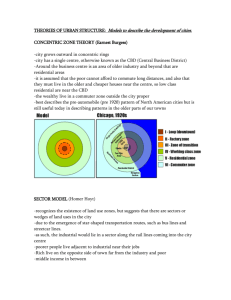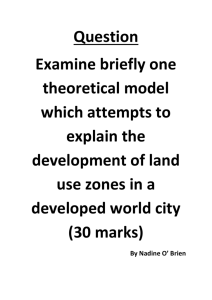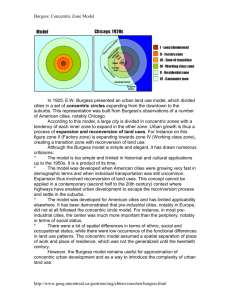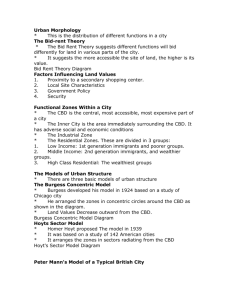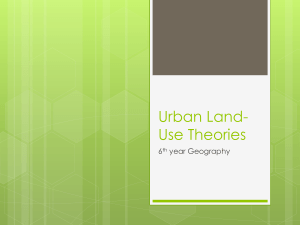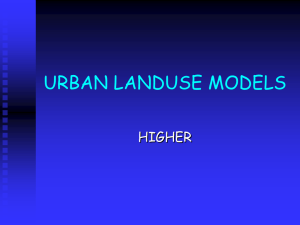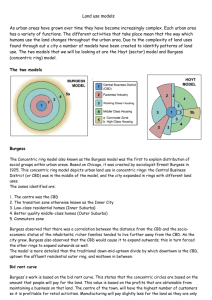Concentric zone model
advertisement
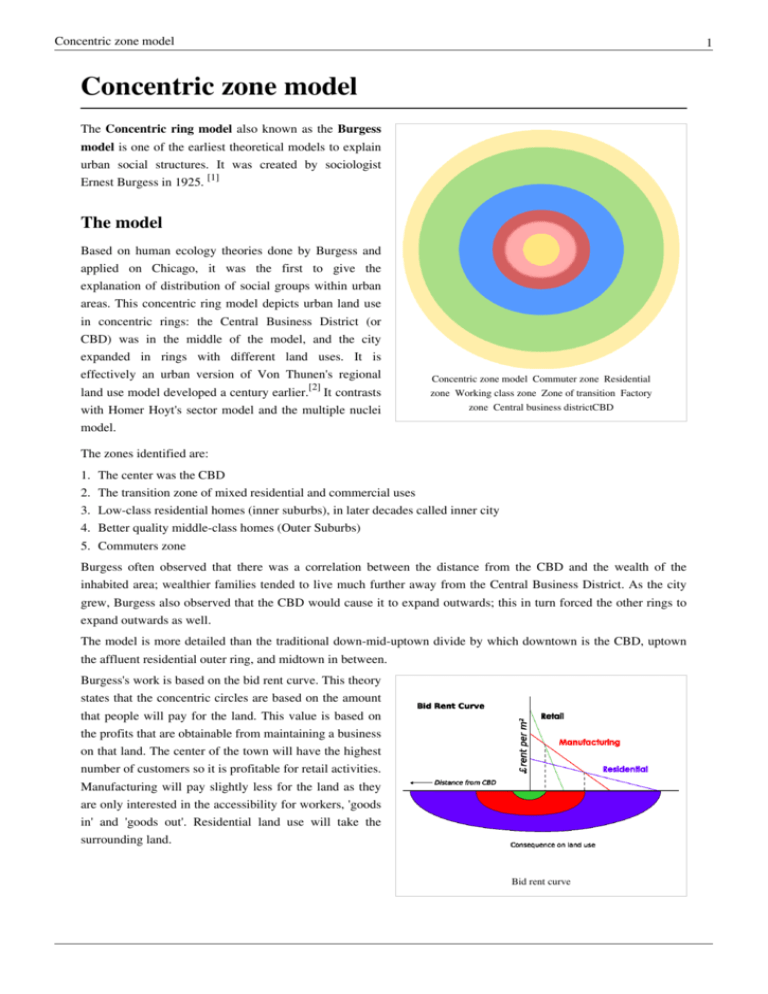
Concentric zone model 1 Concentric zone model The Concentric ring model also known as the Burgess model is one of the earliest theoretical models to explain urban social structures. It was created by sociologist Ernest Burgess in 1925. [1] The model Based on human ecology theories done by Burgess and applied on Chicago, it was the first to give the explanation of distribution of social groups within urban areas. This concentric ring model depicts urban land use in concentric rings: the Central Business District (or CBD) was in the middle of the model, and the city expanded in rings with different land uses. It is effectively an urban version of Von Thunen's regional land use model developed a century earlier.[2] It contrasts with Homer Hoyt's sector model and the multiple nuclei model. Concentric zone model Commuter zone Residential zone Working class zone Zone of transition Factory zone Central business districtCBD The zones identified are: 1. 2. 3. 4. 5. The center was the CBD The transition zone of mixed residential and commercial uses Low-class residential homes (inner suburbs), in later decades called inner city Better quality middle-class homes (Outer Suburbs) Commuters zone Burgess often observed that there was a correlation between the distance from the CBD and the wealth of the inhabited area; wealthier families tended to live much further away from the Central Business District. As the city grew, Burgess also observed that the CBD would cause it to expand outwards; this in turn forced the other rings to expand outwards as well. The model is more detailed than the traditional down-mid-uptown divide by which downtown is the CBD, uptown the affluent residential outer ring, and midtown in between. Burgess's work is based on the bid rent curve. This theory states that the concentric circles are based on the amount that people will pay for the land. This value is based on the profits that are obtainable from maintaining a business on that land. The center of the town will have the highest number of customers so it is profitable for retail activities. Manufacturing will pay slightly less for the land as they are only interested in the accessibility for workers, 'goods in' and 'goods out'. Residential land use will take the surrounding land. Bid rent curve Concentric zone model Criticisms The model has been challenged by many contemporary urban geographers. First, the model does not work well with cities outside the United States, in particular with those developed under different historical contexts. Even in the United States, because of changes such as advancement in transportation and information technology and transformation in global economy, cities are no longer organized with clear "zones" (see: Los Angeles School of Urban Analysis). • It describes the peculiar American geography, where the inner city is poor while suburbs are wealthy; the converse is the norm elsewhere • It assumes an isotropic plain - an even, unchanging landscape • Physical features - land may restrict growth of certain sectors; hills and water features may make some locations unusually desirable for residential purposes • Commuter villages defy the theory, being in the commuter zone but located far from the city • Decentralization of shops, manufacturing industry, and entertainment • Urban regeneration and gentrification - more expensive property can be found in 'low class' housing areas • Many new housing estates were built on the edges of cities in Britain • It does not address local urban politics and forces of globalization • The model does not fit polycentric cities, for example Stoke-on-Trent References [1] Hofstra University (http:/ / people. hofstra. edu/ geotrans/ eng/ ch6en/ conc6en/ burgess. html) [2] Jean-Paul Rodrigue, Urban Land Use Models (http:/ / people. hofstra. edu/ geotrans/ eng/ ch6en/ conc6en/ ch6c2en. html) in Urban Land Use and Transportation External links • Concentric Zone model shown at the University of North Carolina at Charlotte (http://www.uncc.edu/ hscampbe/landuse/b-models/B-3mods.html) [Dead link] 2 Article Sources and Contributors Article Sources and Contributors Concentric zone model Source: http://en.wikipedia.org/w/index.php?oldid=408063269 Contributors: Alan Liefting, Anthonydejesus, EurekaLott, Flyingember, Francium12, GraafGeorge, GreatWhiteNortherner, Immunize, IncognitoErgoSum, Itai, Jim.henderson, JohnCD, Josenel, Kingpin13, Leesi09, Mild Bill Hiccup, Pbrower2a, Philip Trueman, Pondle, Restraining, Shadowjams, Stannered, SuzanneKn, SyntaxError55, Teles, The2cheat, TwoOneTwo, Utcursch, Verne Equinox, Vuo, Xezbeth, Ynhockey, 97 anonymous edits Image Sources, Licenses and Contributors Image:burgess model1.svg Source: http://en.wikipedia.org/w/index.php?title=File:Burgess_model1.svg License: unknown Contributors: User:Stannered Image:bid rent1.svg Source: http://en.wikipedia.org/w/index.php?title=File:Bid_rent1.svg License: GNU Free Documentation License Contributors: SyntaxError55 talk Original uploader was SyntaxError55 at en.wikipedia Later version(s) were uploaded by Prodego at en.wikipedia. License Creative Commons Attribution-Share Alike 3.0 Unported http:/ / creativecommons. org/ licenses/ by-sa/ 3. 0/ 3
